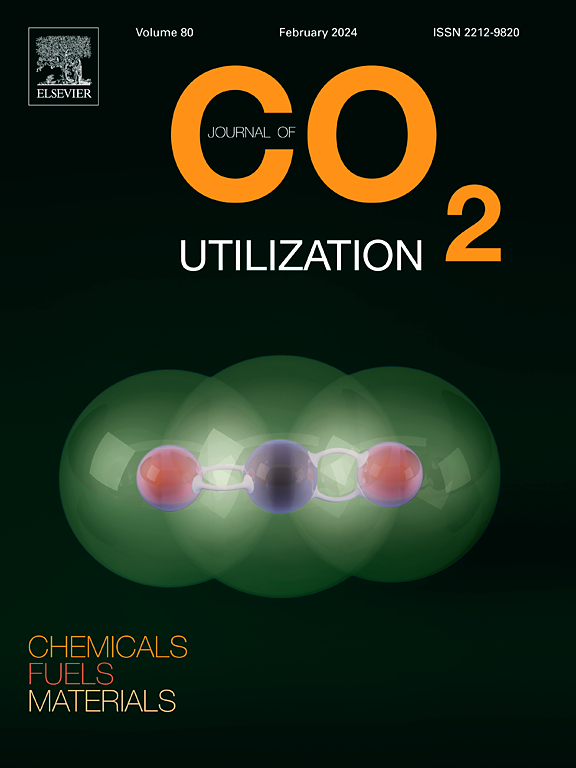Adaptabilities of promoters in hydrate-based CO2 capture from simulated flue gases with high-temperature water vapor
IF 8.4
2区 工程技术
Q1 CHEMISTRY, MULTIDISCIPLINARY
引用次数: 0
Abstract
Besides CO2/N2 mixed gases, actual flue gases also contain high-temperature water vapor exceeding 100 °C. For the hydrate-based CO2 capture technology from flue gases, except for conventional hydrate formation promoter sodium dodecyl sulfate (SDS), another eco-friendly and high-efficient L-methionine (L-Met) recently emerges, both with great application potential. By using two liquid-injecting modes, three liquids with both 640 and 160 ml volumes of pure water and solutions of two promoters were heated to 110 °C and then injected inside a reactor containing mixed gases to form CO2 hydrates. Specific adaptabilities and accelerating mechanisms of two promoters were then investigated under high-temperature water vapor scenario. The results indicate that both 0.1 and 1.0 wt% concentrations of promoters embody more significant accelerating effects on hydrate formation than pure water, and the promoter with a concentration of 0.1 wt% has a better effect. Considering the nozzle blockage and promotion efficiency, SDS is more suitable for 0.8 mm nozzles, and L-Met is more suitable for 0.1 mm nozzles. In terms of final averaged water conversion ratios to hydrate, 1.0 wt% SDS appears higher adaptability to 640 ml liquids and 0.1 wt% L-Met to 160 ml ones. The specific acting extent of SDS appears deeper than that of L-Met and the hydrate formed using SDS has coarse-grained morphology and that using L-Met the spherical one. This implies during hydrate formations by using SDS, some liquid water might be conserved inside the capillary pores acting as the water-source to foster continuous hydrate growth; for using L-Met, hydrate formation can absorb some liquid water from a relatively large distance through mobilization behavior of liquid water. This study provides some reference for future industrial-scale application of hydrate-based decarbonization technology from flue gases, especially under high-temperature water vapor scenario.
促进剂在含高温水蒸气的模拟烟气中水合物基CO2捕集中的适应性
除了CO2/N2混合气体外,实际烟气中还含有超过100°C的高温水蒸气。在基于水合物的烟气CO2捕集技术中,除了传统的水合物形成促进剂十二烷基硫酸钠(SDS)外,最近又出现了一种环保高效的l -蛋氨酸(L-Met),两者都具有很大的应用潜力。采用两种注液方式,将体积分别为640和160 ml的纯水和两种促进剂溶液的三种液体加热至110℃,注入含有混合气体的反应器中形成CO2水合物。研究了两种促进剂在高温水蒸气环境下的具体适应性和加速机理。结果表明,与纯水相比,0.1和1.0 wt%浓度的促进剂对水合物形成的加速作用更显著,且0.1 wt%浓度的促进剂效果更好。考虑喷嘴堵塞和促进效率,SDS更适合0.8 mm喷嘴,L-Met更适合0.1 mm喷嘴。就最终平均水与水合物的转化率而言,1.0 wt% SDS对640 ml液体的适应性更高,0.1 wt% L-Met对160 ml液体的适应性更高。SDS比L-Met的比作用程度更深,SDS形成的水合物晶粒较粗,L-Met形成的水合物为球形。这意味着在SDS水合物形成过程中,一些液态水可能在毛细管孔内作为水源保存,从而促进水合物的持续生长;对于L-Met,水合物形成可以通过液态水的动员行为,从较远的距离吸收部分液态水。该研究为未来烟气水合物脱碳技术的工业规模应用,特别是高温水蒸气场景下的脱碳技术提供了一定的参考。
本文章由计算机程序翻译,如有差异,请以英文原文为准。
求助全文
约1分钟内获得全文
求助全文
来源期刊

Journal of CO2 Utilization
CHEMISTRY, MULTIDISCIPLINARY-ENGINEERING, CHEMICAL
CiteScore
13.90
自引率
10.40%
发文量
406
审稿时长
2.8 months
期刊介绍:
The Journal of CO2 Utilization offers a single, multi-disciplinary, scholarly platform for the exchange of novel research in the field of CO2 re-use for scientists and engineers in chemicals, fuels and materials.
The emphasis is on the dissemination of leading-edge research from basic science to the development of new processes, technologies and applications.
The Journal of CO2 Utilization publishes original peer-reviewed research papers, reviews, and short communications, including experimental and theoretical work, and analytical models and simulations.
 求助内容:
求助内容: 应助结果提醒方式:
应助结果提醒方式:


